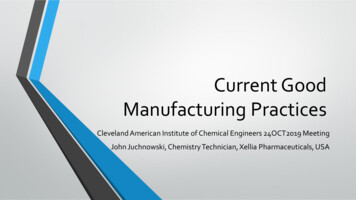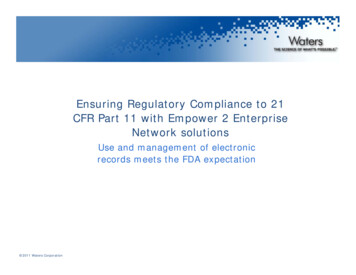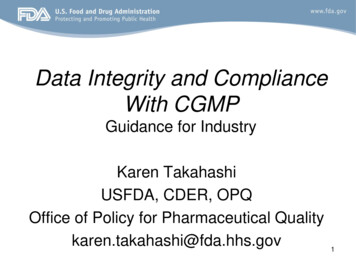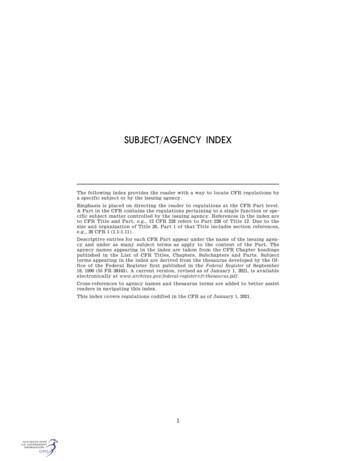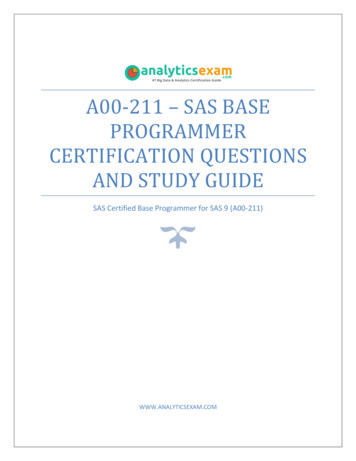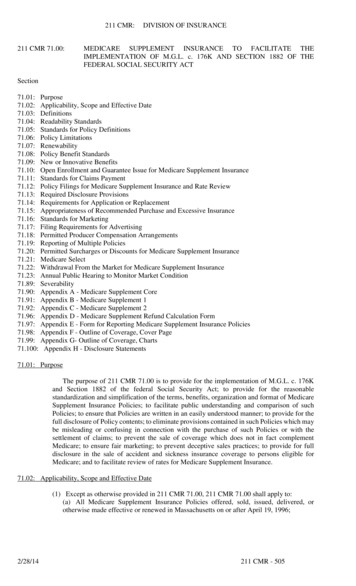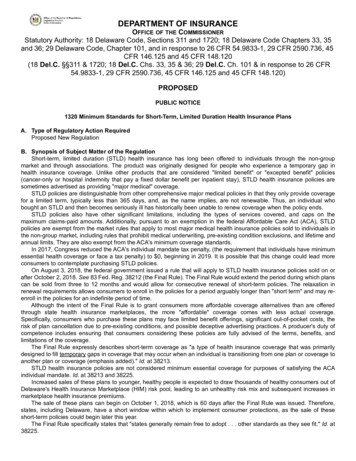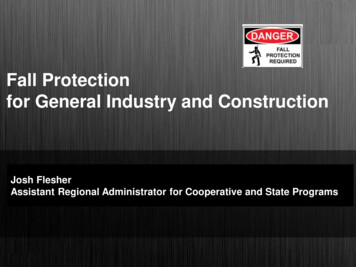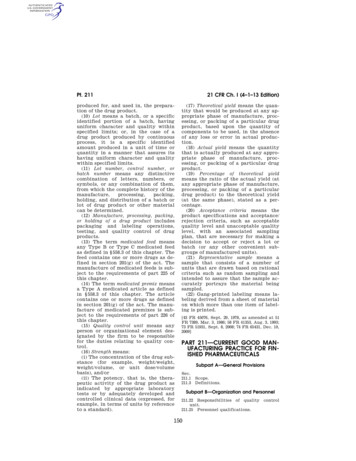
Transcription
erowe on DSK2VPTVN1PROD with CFRPt. 21121 CFR Ch. I (4–1–13 Edition)produced for, and used in, the preparation of the drug product.(10) Lot means a batch, or a specificidentified portion of a batch, havinguniform character and quality withinspecified limits; or, in the case of adrug product produced by continuousprocess, it is a specific identifiedamount produced in a unit of time orquantity in a manner that assures itshaving uniform character and qualitywithin specified limits.(11) Lot number, control number, orbatch number means any distinctivecombination of letters, numbers, orsymbols, or any combination of them,from which the complete history of themanufacture,processing,packing,holding, and distribution of a batch orlot of drug product or other materialcan be determined.(12) Manufacture, processing, packing,or holding of a drug product includespackaging and labeling operations,testing, and quality control of drugproducts.(13) The term medicated feed meansany Type B or Type C medicated feedas defined in § 558.3 of this chapter. Thefeed contains one or more drugs as defined in section 201(g) of the act. Themanufacture of medicated feeds is subject to the requirements of part 225 ofthis chapter.(14) The term medicated premix meansa Type A medicated article as definedin § 558.3 of this chapter. The articlecontains one or more drugs as definedin section 201(g) of the act. The manufacture of medicated premixes is subject to the requirements of part 226 ofthis chapter.(15) Quality control unit means anyperson or organizational element designated by the firm to be responsiblefor the duties relating to quality control.(16) Strength means:(i) The concentration of the drug substance (for example, weight/weight,weight/volume, or unit dose/volumebasis), and/or(ii) The potency, that is, the therapeutic activity of the drug product asindicated by appropriate laboratorytests or by adequately developed andcontrolled clinical data (expressed, forexample, in terms of units by referenceto a standard).(17) Theoretical yield means the quantity that would be produced at any appropriate phase of manufacture, processing, or packing of a particular drugproduct, based upon the quantity ofcomponents to be used, in the absenceof any loss or error in actual production.(18) Actual yield means the quantitythat is actually produced at any appropriate phase of manufacture, processing, or packing of a particular drugproduct.(19) Percentage of theoretical yieldmeans the ratio of the actual yield (atany appropriate phase of manufacture,processing, or packing of a particulardrug product) to the theoretical yield(at the same phase), stated as a percentage.(20) Acceptance criteria means theproduct specifications and acceptance/rejection criteria, such as acceptablequality level and unacceptable qualitylevel, with an associated samplingplan, that are necessary for making adecision to accept or reject a lot orbatch (or any other convenient subgroups of manufactured units).(21) Representative sample means asample that consists of a number ofunits that are drawn based on rationalcriteria such as random sampling andintended to assure that the sample accurately portrays the material beingsampled.(22) Gang-printed labeling means labeling derived from a sheet of materialon which more than one item of labeling is printed.[43 FR 45076, Sept. 29, 1978, as amended at 51FR 7389, Mar. 3, 1986; 58 FR 41353, Aug. 3, 1993;73 FR 51931, Sept. 8, 2008; 74 FR 65431, Dec. 10,2009]PART 211—CURRENT GOOD MANUFACTURING PRACTICE FOR FINISHED PHARMACEUTICALSSubpart A—General ProvisionsSec.211.1211.3Scope.Definitions.Subpart B—Organization and Personnel211.22 Responsibilities of qualityunit.211.25 Personnel qualifications.150VerDate Mar 15 201010:14 May 21, 2013Jkt 229071PO 00000Frm 00160Fmt 8010Sfmt 8010Y:\SGML\229071.XXX229071control
Food and Drug Administration, HHS211.28211.34§ 211.1Personnel responsibilities.Consultants.211.137Expiration dating.Subpart H—Holding and DistributionSubpart C—Buildings and Facilities211.42 Design and construction features.211.44 Lighting.211.46 Ventilation, air filtration, air heatingand cooling.211.48 Plumbing.211.50 Sewage and refuse.211.52 Washing and toilet facilities.211.56 Sanitation.211.58 Maintenance.Subpart D—Equipment211.63 Equipment design, size, and location.211.65 Equipment construction.211.67 Equipment cleaning and maintenance.211.68 Automatic, mechanical, and electronic equipment.211.72 Filters.Subpart E—Control of Components andDrug Product Containers and Closures211.80 General requirements.211.82 Receipt and storage of untested components, drug product containers, andclosures.211.84 Testing and approval or rejection ofcomponents, drug product containers,and closures.211.86 Use of approved components, drugproduct containers, and closures.211.87 Retesting of approved components,drug product containers, and closures.211.89 Rejected components, drug productcontainers, and closures.211.94 Drug product containers and closures.211.142211.150Subpart I—Laboratory 211.176General requirements.Testing and release for distribution.Stability testing.Special testing requirements.Reserve samples.Laboratory animals.Penicillin contamination.Subpart J—Records and Reports211.180 General requirements.211.182 Equipment cleaning and use log.211.184 Component, drug product container,closure, and labeling records.211.186 Master production and controlrecords.211.188 Batchproductionandcontrolrecords.211.192 Production record review.211.194 Laboratory records.211.196 Distribution records.211.198 Complaint files.Subpart K—Returned and Salvaged DrugProducts211.204211.208Returned drug products.Drug product salvaging.AUTHORITY: 21 U.S.C. 321, 351, 352, 355, 360b,371, 374; 42 U.S.C. 216, 262, 263a, 264.SOURCE: 43 FR 45077, Sept. 29, 1978, unlessotherwise noted.Subpart F—Production and ProcessControlsSubpart A—General Provisions211.100 Written procedures; deviations.211.101 Charge-in of components.211.103 Calculation of yield.211.105 Equipment identification.211.110 Sampling and testing of in-processmaterials and drug products.211.111 Time limitations on production.211.113 Control of microbiological contamination.211.115 Reprocessing.Subpart G—Packaging and LabelingControlerowe on DSK2VPTVN1PROD with CFRWarehousing procedures.Distribution procedures.211.122 Materials examination and usagecriteria.211.125 Labeling issuance.211.130 Packaging and labeling operations.211.132 Tamper-evident packaging requirements for over-the-counter (OTC) humandrug products.211.134 Drug product inspection.§ 211.1 Scope.(a) The regulations in this part contain the minimum current good manufacturing practice for preparation ofdrug products (excluding positronemission tomography drugs) for administration to humans or animals.(b) The current good manufacturingpractice regulations in this chapter asthey pertain to drug products; in parts600 through 680 of this chapter, as theypertain to drugs that are also biological products for human use; and in part1271 of this chapter, as they are applicable to drugs that are also humancells, tissues, and cellular and tissuebased products (HCT/Ps) and that aredrugs (subject to review under an application submitted under section 505 of151VerDate Mar 15 201010:14 May 21, 2013Jkt 229071PO 00000Frm 00161Fmt 8010Sfmt 8010Y:\SGML\229071.XXX229071
§ 211.321 CFR Ch. I (4–1–13 Edition)the act or under a biological product license application under section 351 ofthe Public Health Service Act); supplement and do not supersede the regulations in this part unless the regulations explicitly provide otherwise. Inthe event of a conflict between applicable regulations in this part and inother parts of this chapter, or in parts600 through 680 of this chapter, or inpart 1271 of this chapter, the regulationspecifically applicable to the drugproduct in question shall supersede themore general.(c) Pending consideration of a proposed exemption, published in the FEDERAL REGISTER of September 29, 1978,the requirements in this part shall notbe enforced for OTC drug products ifthe products and all their ingredientsare ordinarily marketed and consumedas human foods, and which productsmay also fall within the legal definition of drugs by virtue of their intended use. Therefore, until further notice, regulations under part 110 of thischapter, and where applicable, parts 113to 129 of this chapter, shall be appliedin determining whether these OTC drugproducts that are also foods are manufactured, processed, packed, or heldunder current good manufacturingpractice.[43 FR 45077, Sept. 29, 1978, as amended at 62FR 66522, Dec. 19, 1997; 69 FR 29828, May 25,2004; 74 FR 65431, Dec. 10, 2009]§ 211.3 Definitions.The definitions set forth in § 210.3 ofthis chapter apply in this part.erowe on DSK2VPTVN1PROD with CFRSubpart B—Organization andPersonnel§ 211.22 Responsibilitiesofqualitycontrol unit.(a) There shall be a quality controlunit that shall have the responsibilityand authority to approve or reject allcomponents, drug product containers,closures, in-process materials, packaging material, labeling, and drugproducts, and the authority to reviewproduction records to assure that noerrors have occurred or, if errors haveoccurred, that they have been fully investigated. The quality control unitshall be responsible for approving or rejecting drug products manufactured,processed, packed, or held under contract by another company.(b) Adequate laboratory facilities forthe testing and approval (or rejection)of components, drug product containers, closures, packaging materials,in-process materials, and drug productsshall be available to the quality control unit.(c) The quality control unit shallhave the responsibility for approvingor rejecting all procedures or specifications impacting on the identity,strength, quality, and purity of thedrug product.(d) The responsibilities and procedures applicable to the quality controlunit shall be in writing; such writtenprocedures shall be followed.§ 211.25Personnel qualifications.(a) Each person engaged in the manufacture, processing, packing, or holdingof a drug product shall have education,training, and experience, or any combination thereof, to enable that personto perform the assigned functions.Training shall be in the particular operations that the employee performsand in current good manufacturingpractice (including the current goodmanufacturing practice regulations inthis chapter and written procedures required by these regulations) as they relate to the employee’s functions.Training in current good manufacturing practice shall be conducted byqualified individuals on a continuingbasis and with sufficient frequency toassure that employees remain familiarwith CGMP requirements applicable tothem.(b) Each person responsible for supervising the manufacture, processing,packing, or holding of a drug productshall have the education, training, andexperience, or any combination thereof, to perform assigned functions insuch a manner as to provide assurancethat the drug product has the safety,identity, strength, quality, and puritythat it purports or is represented topossess.(c) There shall be an adequate number of qualified personnel to performand supervise the manufacture, processing, packing, or holding of each drugproduct.152VerDate Mar 15 201010:14 May 21, 2013Jkt 229071PO 00000Frm 00162Fmt 8010Sfmt 8010Y:\SGML\229071.XXX229071
Food and Drug Administration, HHS§ 211.28§ 211.42Personnel responsibilities.(a) Personnel engaged in the manufacture, processing, packing, or holdingof a drug product shall wear cleanclothing appropriate for the dutiesthey perform. Protective apparel, suchas head, face, hand, and arm coverings,shall be worn as necessary to protectdrug products from contamination.(b) Personnel shall practice goodsanitation and health habits.(c) Only personnel authorized by supervisory personnel shall enter thoseareas of the buildings and facilitiesdesignated as limited-access areas.(d) Any person shown at any time (either by medical examination or supervisory observation) to have an apparent illness or open lesions that may adversely affect the safety or quality ofdrug products shall be excluded fromdirect contact with components, drugproduct containers, closures, in-processmaterials, and drug products until thecondition is corrected or determined bycompetent medical personnel not tojeopardize the safety or quality of drugproducts. All personnel shall be instructed to report to supervisory personnel any health conditions that mayhave an adverse effect on drug products.§ 211.34Consultants.Consultants advising on the manufacture, processing, packing, or holdingof drug products shall have sufficienteducation, training, and experience, orany combination thereof, to advise onthe subject for which they are retained.Records shall be maintained statingthe name, address, and qualificationsof any consultants and the type ofservice they provide.Subpart C—Buildings and Facilitieserowe on DSK2VPTVN1PROD with CFR§ 211.42 Design and construction features.(a) Any building or buildings used inthe manufacture, processing, packing,or holding of a drug product shall be ofsuitable size, construction and locationto facilitate cleaning, maintenance,and proper operations.(b) Any such building shall have adequate space for the orderly placementof equipment and materials to preventmixups between different components,drug product containers, closures, labeling, in-process materials, or drugproducts, and to prevent contamination. The flow of components, drugproduct containers, closures, labeling,in-process materials, and drug productsthrough the building or buildings shallbe designed to prevent contamination.(c) Operations shall be performedwithin specifically defined areas of adequate size. There shall be separate ordefined areas or such other control systems for the firm’s operations as arenecessary to prevent contamination ormixups during the course of the following procedures:(1) Receipt, identification, storage,and withholding from use of components, drug product containers, closures, and labeling, pending the appropriate sampling, testing, or examination by the quality control unit beforerelease for manufacturing or packaging;(2) Holding rejected components,drug product containers, closures, andlabeling before disposition;(3) Storage of released components,drug product containers, closures, andlabeling;(4) Storage of in-process materials;(5) Manufacturing and processing operations;(6) Packaging and labeling operations;(7) Quarantine storage before releaseof drug products;(8) Storage of drug products after release;(9) Control and laboratory operations;(10) Aseptic processing, which includes as appropriate:(i) Floors, walls, and ceilings ofsmooth, hard surfaces that are easilycleanable;(ii) Temperature and humidity controls;(iii) An air supply filtered throughhigh-efficiency particulate air filtersunder positive pressure, regardless ofwhether flow is laminar or nonlaminar;(iv) A system for monitoring environmental conditions;(v) A system for cleaning and disinfecting the room and equipment toproduce aseptic conditions;153VerDate Mar 15 201010:14 May 21, 2013Jkt 229071PO 00000Frm 00163Fmt 8010Sfmt 8010Y:\SGML\229071.XXX229071
§ 211.4421 CFR Ch. I (4–1–13 Edition)(vi) A system for maintaining anyequipment used to control the asepticconditions.(d) Operations relating to the manufacture, processing, and packing of penicillin shall be performed in facilitiesseparate from those used for other drugproducts for human use.[43 FR 45077, Sept. 29, 1978, as amended at 48FR 11426, Mar. 18, 1983]§ 211.50Sewage and refuse.[43 FR 45077, Sept. 29, 1978, as amended at 60FR 4091, Jan. 20, 1995]Sewage, trash, and other refuse inand from the building and immediatepremises shall be disposed of in a safeand sanitary manner.§ 211.44§ 211.52Lighting.Adequate lighting shall be providedin all areas.§ 211.46 Ventilation, air filtration, airheating and cooling.(a) Adequate ventilation shall be provided.(b) Equipment for adequate controlover air pressure, micro-organisms,dust, humidity, and temperature shallbe provided when appropriate for themanufacture, processing, packing, orholding of a drug product.(c) Air filtration systems, includingprefilters and particulate matter airfilters, shall be used when appropriateon air supplies to production areas. Ifair is recirculated to production areas,measures shall be taken to control recirculation of dust from production. Inareas where air contamination occursduring production, there shall be adequate exhaust systems or other systems adequate to control contaminants.(d) Air-handling systems for the manufacture, processing, and packing ofpenicillin shall be completely separatefrom those for other drug products forhuman use.§ 211.48erowe on DSK2VPTVN1PROD with CFRbreak or other mechanical device toprevent back-siphonage.Plumbing.(a) Potable water shall be suppliedunder continuous positive pressure in aplumbing system free of defects thatcould contribute contamination to anydrug product. Potable water shall meetthe standards prescribed in the Environmental Protection Agency’s Primary Drinking Water Regulations setforth in 40 CFR part 141. Water notmeeting such standards shall not bepermitted in the potable water system.(b) Drains shall be of adequate sizeand, where connected directly to asewer, shall be provided with an airWashing and toilet facilities.Adequate washing facilities shall beprovided, including hot and cold water,soap or detergent, air driers or singleservice towels, and clean toilet facilities easily accesible to working areas.§ 211.56Sanitation.(a) Any building used in the manufacture, processing, packing, or holding ofa drug product shall be maintained in aclean and sanitary condition, Any suchbuilding shall be free of infestation byrodents, birds, insects, and othervermin (other than laboratory animals). Trash and organic waste mattershall be held and disposed of in a timely and sanitary manner.(b) There shall be written proceduresassigning responsibility for sanitationand describing in sufficient detail thecleaning schedules, methods, equipment, and materials to be used incleaning the buildings and facilities;such written procedures shall be followed.(c) There shall be written proceduresfor use of suitable rodenticides, insecticides, fungicides, fumigating agents,and cleaning and sanitizing agents.Such written procedures shall be designed to prevent the contamination ofequipment, components, drug productcontainers, closures, packaging, labeling materials, or drug products andshall be followed. Rodenticides, insecticides, and fungicides shall not be usedunless registered and used in accordance with the Federal Insecticide, Fungicide, and Rodenticide Act (7 U.S.C.135).(d) Sanitation procedures shall applyto work performed by contractors ortemporary employees as well as workperformed by full-time employees during the ordinary course of operations.154VerDate Mar 15 201010:14 May 21, 2013Jkt 229071PO 00000Frm 00164Fmt 8010Sfmt 8010Y:\SGML\229071.XXX229071
Food and Drug Administration, HHS§ 211.58§ 211.68Maintenance.Any building used in the manufacture, processing, packing, or holding ofa drug product shall be maintained in agood state of repair.Subpart D—Equipment§ 211.63 Equipment design, size, andlocation.Equipment used in the manufacture,processing, packing, or holding of adrug product shall be of appropriate design, adequate size, and suitably located to facilitate operations for its intended use and for its cleaning andmaintenance.§ 211.65Equipment construction.(a) Equipment shall be constructed sothat surfaces that contact components,in-process materials, or drug productsshall not be reactive, additive, or absorptive so as to alter the safety, identity, strength, quality, or purity of thedrug product beyond the official orother established requirements.(b) Any substances required for operation, such as lubricants or coolants,shall not come into contact with components, drug product containers, closures, in-process materials, or drugproducts so as to alter the safety, identity, strength, quality, or purity of thedrug product beyond the official orother established requirements.erowe on DSK2VPTVN1PROD with CFR§ 211.67 Equipment cleaning and maintenance.(a) Equipment and utensils shall becleaned, maintained, and, as appropriate for the nature of the drug, sanitized and/or sterilized at appropriateintervals to prevent malfunctions orcontamination that would alter thesafety, identity, strength, quality, orpurity of the drug product beyond theofficial or other established requirements.(b) Written procedures shall be established and followed for cleaning andmaintenance of equipment, includingutensils, used in the manufacture,processing, packing, or holding of adrug product. These procedures shallinclude, but are not necessarily limitedto, the following:(1) Assignment of responsibility forcleaning and maintaining equipment;(2) Maintenance and cleaning schedules, including, where appropriate,sanitizing schedules;(3) A description in sufficient detailof the methods, equipment, and materials used in cleaning and maintenanceoperations, and the methods of disassembling and reassembling equipment as necessary to assure propercleaning and maintenance;(4) Removal or obliteration of previous batch identification;(5) Protection of clean equipmentfrom contamination prior to use;(6) Inspection of equipment for cleanliness immediately before use.(c) Records shall be kept of maintenance, cleaning, sanitizing, and inspection as specified in §§ 211.180 and 211.182.[43 FR 45077, Sept. 29, 1978, as amended at 73FR 51931, Sept. 8, 2008]§ 211.68 Automatic, mechanical, andelectronic equipment.(a) Automatic, mechanical, or electronic equipment or other types ofequipment, including computers, or related systems that will perform a function satisfactorily, may be used in themanufacture, processing, packing, andholding of a drug product. If suchequipment is so used, it shall be routinely calibrated, inspected, or checkedaccording to a written program designed to assure proper performance.Written records of those calibrationchecks and inspections shall be maintained.(b) Appropriate controls shall be exercised over computer or related systems to assure that changes in masterproduction and control records or otherrecords are instituted only by authorized personnel. Input to and outputfrom the computer or related system offormulas or other records or data shallbe checked for accuracy. The degreeandfrequencyofinput/outputverification shall be based on the complexity and reliability of the computeror related system. A backup file of dataentered into the computer or relatedsystem shall be maintained exceptwhere certain data, such as calculations performed in connection with laboratory analysis, are eliminated bycomputerization or other automated155VerDate Mar 15 201010:14 May 21, 2013Jkt 229071PO 00000Frm 00165Fmt 8010Sfmt 8010Y:\SGML\229071.XXX229071
§ 211.7221 CFR Ch. I (4–1–13 Edition)processes. In such instances a writtenrecord of the program shall be maintained along with appropriate validation data. Hard copy or alternative systems, such as duplicates, tapes, ormicrofilm, designed to assure thatbackup data are exact and completeand that it is secure from alteration,inadvertent erasures, or loss shall bemaintained.(c) Such automated equipment usedfor performance of operations addressed by §§ 211.101(c) or (d), 211.103,211.182, or 211.188(b)(11) can satisfy therequirements included in those sections relating to the performance of anoperation by one person and checkingby another person if such equipment isused in conformity with this section,and one person checks that the equipment properly performed the operation.[43 FR 45077, Sept. 29, 1978, as amended at 60FR 4091, Jan. 20, 1995; 73 FR 51932, Sept. 8,2008]§ 211.72 Filters.Filters for liquid filtration used inthe manufacture, processing, or packing of injectable drug products intended for human use shall not releasefibers into such products. Fiber-releasing filters may be used when it is notpossible to manufacture such productswithout the use of these filters. If useof a fiber-releasing filter is necessary,an additional nonfiber-releasing filterhaving a maximum nominal pore sizerating of 0.2 micron (0.45 micron if themanufacturing conditions so dictate)shall subsequently be used to reducethe content of particles in theinjectable drug product. The use of anasbestos-containing filter is prohibited.[73 FR 51932, Sept. 8, 2008]erowe on DSK2VPTVN1PROD with CFRSubpart E—Control of Components and Drug Product Containers and Closures§ 211.80 General requirements.(a) There shall be written proceduresdescribing in sufficient detail the receipt, identification, storage, handling,sampling, testing, and approval or rejection of components and drug product containers and closures; such written procedures shall be followed.(b) Components and drug productcontainers and closures shall at alltimes be handled and stored in a manner to prevent contamination.(c) Bagged or boxed components ofdrug product containers, or closuresshall be stored off the floor and suitably spaced to permit cleaning and inspection.(d) Each container or grouping ofcontainers for components or drugproduct containers, or closures shall beidentified with a distinctive code foreach lot in each shipment received.This code shall be used in recording thedisposition of each lot. Each lot shallbe appropriately identified as to itsstatus (i.e., quarantined, approved, orrejected).§ 211.82 Receipt and storage of untested components, drug product containers, and closures.(a) Upon receipt and before acceptance, each container or grouping ofcontainers of components, drug product containers, and closures shall beexamined visually for appropriate labeling as to contents, container damage or broken seals, and contamination.(b) Components, drug product containers, and closures shall be storedunder quarantine until they have beentested or examined, whichever is appropriate, and released. Storage withinthe area shall conform to the requirements of § 211.80.[43 FR 45077, Sept. 29, 1978, as amended at 73FR 51932, Sept. 8, 2008]§ 211.84 Testing and approval or rejection of components, drug productcontainers, and closures.(a) Each lot of components, drugproduct containers, and closures shallbe withheld from use until the lot hasbeen sampled, tested, or examined, asappropriate, and released for use by thequality control unit.(b) Representative samples of eachshipment of each lot shall be collectedfor testing or examination. The number of containers to be sampled, andthe amount of material to be takenfrom each container, shall be basedupon appropriate criteria such as statistical criteria for component variability, confidence levels, and degree of156VerDate Mar 15 201010:14 May 21, 2013Jkt 229071PO 00000Frm 00166Fmt 8010Sfmt 8010Y:\SGML\229071.XXX229071
erowe on DSK2VPTVN1PROD with CFRFood and Drug Administration, HHS§ 211.87precision desired, the past quality history of the supplier, and the quantityneeded for analysis and reserve whererequired by § 211.170.(c) Samples shall be collected in accordance with the following procedures:(1) The containers of components selected shall be cleaned when necessaryin a manner to prevent introduction ofcontaminants into the component.(2) The containers shall be opened,sampled, and resealed in a manner designed to prevent contamination oftheir contents and contamination ofother components, drug product containers, or closures.(3) Sterile equipment and asepticsampling techniques shall be used whennecessary.(4) If it is necessary to sample a component from the top, middle, and bottom of its container, such sample subdivisions shall not be composited fortesting.(5) Sample containers shall be identified so that the following informationcan be determined: name of the material sampled, the lot number, the container from which the sample wastaken, the date on which the samplewas taken, and the name of the personwho collected the sample.(6) Containers from which sampleshave been taken shall be marked toshow that samples have been removedfrom them.(d) Samples shall be examined andtested as follows:(1) At least one test shall be conducted to verify the identity of eachcomponent of a drug product. Specificidentity tests, if they exist, shall beused.(2) Each component shall be testedfor conformity with all , and quality. In lieu of suchtesting by the manufacturer, a reportof analysis may be accepted from thesupplier of a component, provided thatat least one specific identity test isconducted on such component by themanufacturer, and provided that themanufacturer establishes the reliability of the supplier’s analysesthrough appropriate validation of thesupplier’s test results at appropriateintervals.(3) Containers and closures shall betested for conformity with all appropriate written specifications. In lieu ofsuch testing by the manufacturer, acertificate of testing may be acceptedfrom the supplier, provided that atleast a visual identification is conducted on such containers/closures bythe manufacturer and provided thatthe manufacturer establishes the reliability of the supplier’s test resultsthrough appropriate validation of thesupplier’s test results at appropriateintervals.(4) When appropriate, componentsshall be microscopically examined.(5) Each lot of a component, drugproduct container, or closure that isliable to contamination with filth, insect infestation, or other extraneousadulterant shall be examined againstestablished specifications for such contamination.(6) Each lot of a component, drugproduct container, or closure with potential for microbiological contamination that is objectionable in view of itsintended use shall be subjected to
Food and Drug Administration, HHS §211.1 211.28 Personnel responsibilities. 211.34 Consultants. Subpart C—Buildings and Facilities 211.42 Design and construction features. 211.44 Lighting. 211.46 Ventilation, air filtration, air heating and cooling. 211.48 Plumbing. 211.50 Sewage and refuse. 211.52 Washing and toilet facilities. 211.56 .
